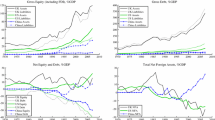Abstract
International mutual funds allow individual investors to diversify abroad at a reasonable cost. This paper tests whether international funds that actively engage in country and security selection outperform passive global benchmarks. We apply a mean-variance efficiency test that incorporates the practical prohibition against short sales of open-end mutual funds. Our tests reject the efficiency of the world equity market portfolio over the sample period, and our funds as a group outperform the inefficient world index. However, we find no evidence of security selectivity ability using a 12-country benchmark. We do find that active international funds provide global diversification benefits. Tests using the Positive Period Weight (PPW) measure of Grinblatt and Titman (1989), which is robust to nonlinearity in fund and benchmark returns, yield similar results.
Similar content being viewed by others
References
Adler, Michael and Bernard Dumas, “International Portfolio Choice and Corporation Finance: A Synthesis.” Journal of Finance 38, 925–984, (1983).
Ahn, C. Seung and Peter Schmidt, Econometric Reviews, forthcoming, (1994).
Cooper, Ian and Evi Kaplanis, “Home Bias in Equity Portfolios, Inflation Hedging, and International Capital Market Equilibrium.” The Review of Financial Studies 7, 45–60, (1994).
Cumby, Robert and Jack Glen, “Evaluating the Performance of International Mutual Funds.” Journal of Finance 45, 497–521, (1990).
Droms, William and David Walker, “Investment Performance of International Mutual Funds.” Journal of Financial Research 1–14, (1994).
Dybvig, Philip and Stephen Ross, “Differential Information and Performance Measurement Using a Security Market Line.” Journal of Finance 40, 383–399, (1985).
Eun, Cheol, and Bruce Resnick, “Estimating the Correlation Structure of International Share Prices.” Journal of Finance 39, 1311–1324, (1984).
Eun, Cheol, Richard Kolodny, and Bruce Resnick, “U.S.-based International Mutual Funds: A Performance Evaluation.” The Journal of Portfolio Management 17, 88–94, (1991).
Gibbons, Michael, Stephen Ross and Jay Shanken, “A Test of the Efficiency of a Given Portfolio.” Econometrica 57, 1121–1152, (1989).
Goetzmann, William, and Roger Ibbotson, “Do Winners Repeat?” The Journal of Portfolio Management 9–18, (1994).
Gourieroux, Christian, Alberto Holly, and Alain Monfort, “Likelihood Ratio Test, Wald Test, and Kuhn-Tucker Test in Linear Models with Inequality Constraints on the Regression Parameters.” Econometrica 50, 63–79, (1982).
Grauer, R., and N. Hakansson, “Gains from International Diversification: 1968–1985.” Journal of Finance 42, 721–739, (1987).
Grinblatt, Mark and Sheridan Titman, “Portfolio Performance Evaluation: Old Issues and New Insights.” Review of Financial Studies 2, 393–421, (1989).
——— ———, “The Persistence of Mutual Fund Performance.” Journal of Finance 47, 1977–1984, (1992).
——— ———, “A Study of Monthly Mutual Fund Returns and Performance Evaluation Techniques.” Journal of Financial and Quantitative Analysis 29, 419–444, (1994).
Harvey, Campbell, “The World Price of Covariance Risk.” Journal of Finance 46, 111–157, (1991).
Hendricks, Darryll, Jayendu Patel, and Richard Zeckhauser, “Hot Hands in Mutual Funds: Short Run Persistence of Relative Performance, 1974–1988.” Journal of Finance 48, 93–131, (1993).
Ippolito, Richard, “On Studies of Mutual Fund Performance, 1962–1991.” Financial Analysts Journal 42–50, (1993).
Jensen, Michael, “The Performance of Mutual Funds in the Period 1945–1964.” Journal of Finance 23, 389–416, (1968).
———, “Risk, the Pricing of Capital Assets and the Evaluation of Investment Portfolios.” Journal of Business 42, 167–247, (1969).
Jorion, Philippe, “Mean/Variance Analysis of Currency Overlays.” Financial Analyst Journal 48–56, (May–June 1993).
Kodde, David, and Franz Palm, “Wald Criteria for Jointly Testing Equality and Inequality Restrictions.” Econometrica 54, 1243–1248, (1986).
Lehmann, Bruce, and David Modest, “Mutual fund performance evaluation: A comparison of benchmarks and benchmarks comparisons.” Journal of Finance 42, 233–265, (1987).
Sharpe, William, “Mutual Fund Performance.” Journal of Business 39, 119–138, (1966).
———, “Asset Allocation: Management Style and Performance Measurement.” Journal of Portfolio Management 18, 7–19, (1992).
Smith, Keith, “Is Fund Growth Related to Fund Performance?” Journal of Portfolio Management 5, 49–54, (1978).
Solnik, Bruno, “An Equilibrium Model of the International Capital Market.” Journal of Economic Theory 500–524, (1974).
———, “The International Pricing of Risk: An Empirical Investigation of TheWorld Capital Market Structure.” Journal of Finance 29, 365–378, (1976).
Treynor, Jack, and Kay Mazuy, “Can Mutual Funds Outguess the Market.” Harvard Business Review 54, 131–136, (1966).
Wolak, Frank, “An Exact Test for Multiple Inequality and Equality Constraints in the Linear Regression Model.” Journal of the American Statistical Association 782–793, (1987).
———, “Local and Global Testing of Linear and Nonlinear Inequality Constraints in Nonlinear Econometric Models.” Econometric Theory 5, 1–35, (1989a).
———, “Testing Inequality Constraints in Linear Econometric Models.” Journal of Econometrics 89, 205–235, (1989b).
———, “The Local Nature of Hypothesis Tests Involving Inequality Constraints in Nonlinear Models.” Econometrica 59, 981–995, (1991).
Author information
Authors and Affiliations
Rights and permissions
About this article
Cite this article
Detzler, M., Wiggins, J. The Performance of Actively Managed International Mutual Funds. Review of Quantitative Finance and Accounting 8, 291–313 (1997). https://doi.org/10.1023/A:1008219106132
Issue Date:
DOI: https://doi.org/10.1023/A:1008219106132




